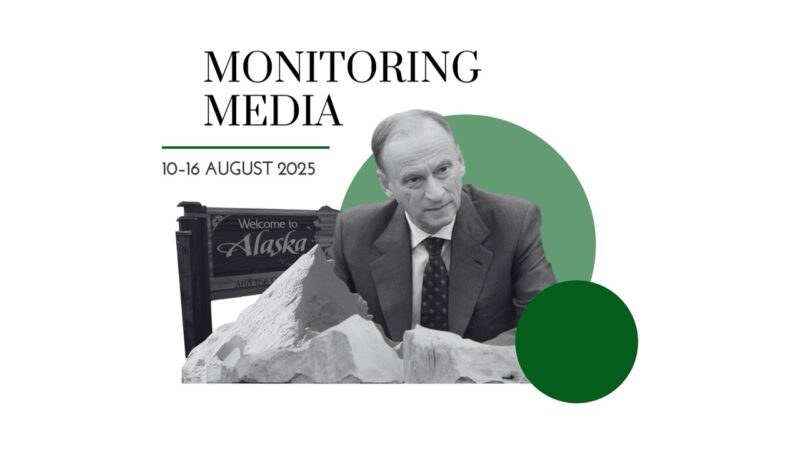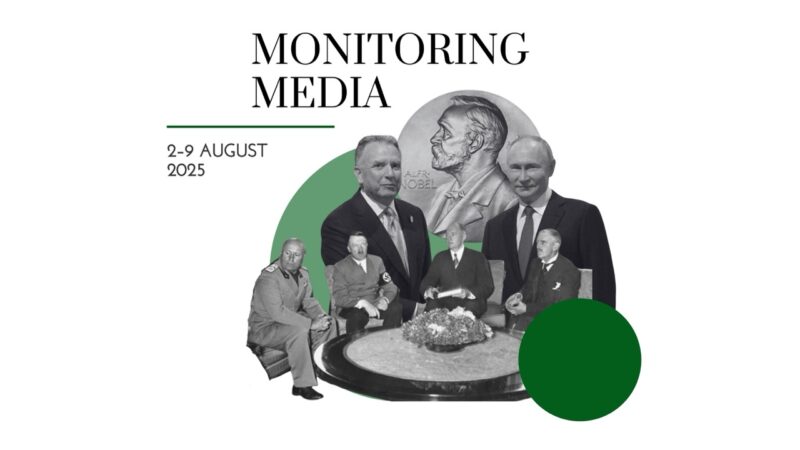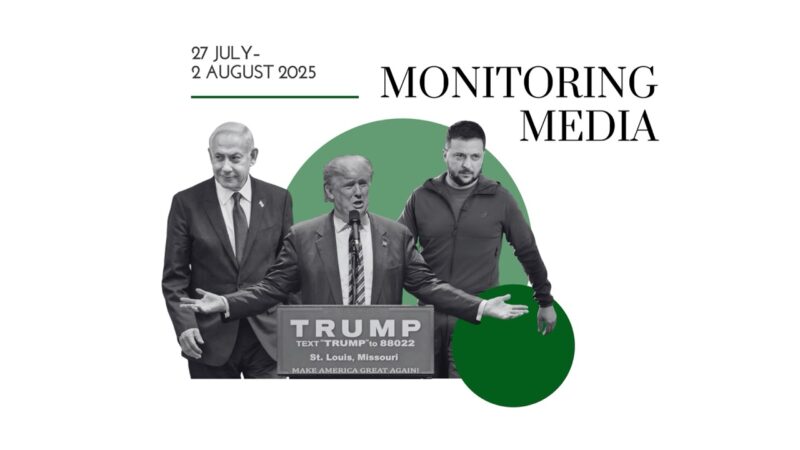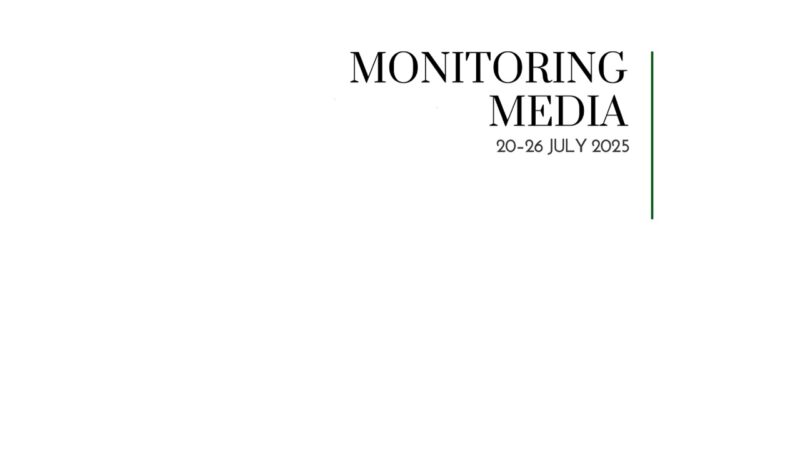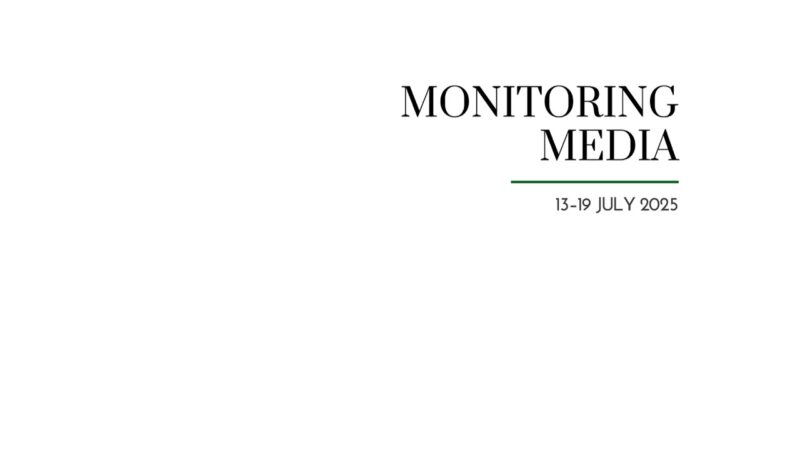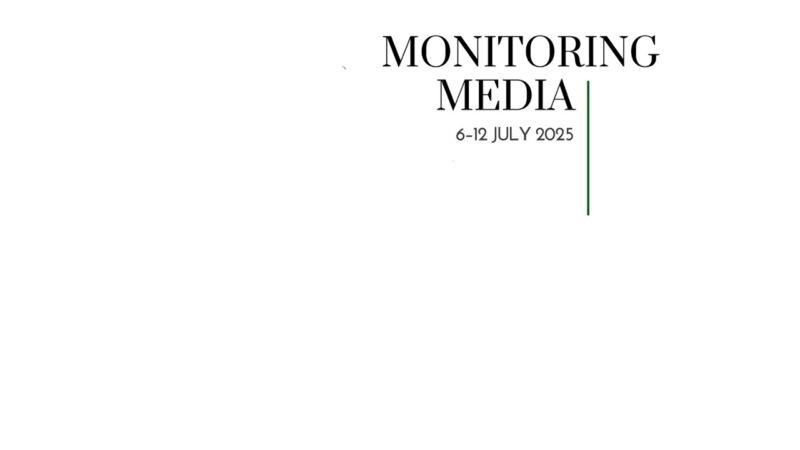Ukraine needs a new storyline

CIUS weekly report on North American media coverage of Ukrainian affairs, 1–7 September 2024
Four publications (The Economist, The National Interest, Foreign Policy, and The Wall Street Journal) were selected to prepare this report on how Ukraine has been portrayed in the North American press during the past week. The sample was compiled based on their impact on public opinion as well as on their professional reputation, popularity among the readership, and topical relevance. These publications represent centrist viewpoints on the political spectrum.
This MMS report covers only the most-read and relevant articles about Ukraine, as ranked by the respective North American publications themselves in the past week. Its scope covers promoted articles on home pages and articles from special sections on Ukraine, with the hashtag #Ukraine, from the paper editions of the publications, and about Ukraine from opinion columns and editorials.
Featured topics
- The world and Ukraine: US restrictions on hitting Russia are hurting Ukraine; the Hundred Years’ War teaches us about the Ukrainian offensive on Kursk; Ukraine needs a new storyline.
- Russia at war: Kursk operation demonstrates Russia’s weakness; Putin signals willingness for talks, offers terms Ukraine deems unacceptable.
MMS summaries
US restrictions on hitting Russia are hurting Ukraine. The editorial board of the Economist argues that Washington’s restrictions on striking Russia are causing significant damage to Ukraine. The arguments for restricting Kyiv’s ability to strike are illogical and weak. The argument that carrying out strikes deep into Russia could lead to an escalation of the conflict or even nuclear war has proved untenable. The Kursk offensive completely dispelled this myth. The argument that the US “administration does not want to jeopardise a ‘reset’ of relations with Moscow at some point in the future” does not stand up to scrutiny, either. The argument that there are no targets in Russia whose destruction could affect the outcome of this war is absurd: “Ukrainian long-range strikes against Russian military targets within Russia’s rear are crucial for degrading Russian military capabilities throughout the theatre, and the lifting of restrictions on Ukraine’s use of Western-provided weapons would allow Ukrainian forces to strike a wide range of significant targets undergirding Russia’s war effort… Some 250 military ‘objects’ are within range of ATACMS, of which only 17 are airfields from which aircraft may have departed. Many of these are large military bases, communications stations, logistics centres, fuel depots and ammunition warehouses that would be hard to move without serious consequences for Russia’s war effort.” According to the Economist, today “Russian planes are better protected by Western guarantees than are Ukrainian civilians.”
Hundred Years’ War teaches us about the Ukrainian offensive on Kursk. Lucian Staiano-Daniels (Foreign Policy) argues that in order to understand Russia’s war against Ukraine, researchers draw many historical comparisons. Among them are numerous comparisons of Russia’s bellicose actions against Ukraine to the trench warfare of the First World War, the battles in Normandy during the Second World War, etc. According to the author, “Three battles in medieval and early modern Europe offer instructive parallels to Ukraine’s Kursk offensive.” First, the Kursk operation can be compared to the campaign that preceded the 1346 Battle of Crécy in northern France during the on-again, off-again conflict known as the Hundred Years’ War. These campaigns are similar in their aim to humiliate the enemy: “An incursion like the one into Kursk demonstrates that the enemy cannot carry out one of the most basic functions of government—security—within its own territory. Panicked and enraged, the enemy may now make rash, counterproductive decisions.” Second, the Ukrainian offensive on Kursk is similar to the brief conflict between Sweden and Denmark late in the Thirty Years’ War. The Swedish raid was not aimed at capturing and holding Danish territory, but the successful campaign allowed them to make serious demands during the negotiations: “In the peace treaty, Sweden gained several provinces from Danish-controlled Norway and exemption from shipping tolls into and out of the Baltic for the next 70 years.” If Ukraine can continue its offensive on Kursk, it could force Russia to fulfil Ukraine’s political goals at “less cost than the deadly grind in southeastern Ukraine.” Third, the lesson of the Holy Roman Empire’s unsuccessful campaign in Pomerania in 1637 is instructive. This historical example demonstrates that successful military operations must be accompanied by equally successful political decisions by both the belligerent country and its allies. According to Staiano-Daniels, “Like all coalitions, Ukraine and its Western supporters, above all the United States, have had to reach limiting compromises. And like in all coalitions, their political goals do not fully align. Past wars offer ominous warnings, but it remains to be seen whether the lack of full US support will fatally limit Ukraine.”
The Kursk operation demonstrates Russia’s weakness. Konstantin Sonin (National Interest) declares that the Kursk operation has shown up Russia’s military weakness and public apathy. During a month of active hostilities on Russian territory, Moscow has not managed to dislodge the Ukrainian Armed Forces or at least stabilize any of the front lines. In the author’s opinion, several conclusions can be drawn from the course of the hostilities in the Kursk region. First, the Ukrainian offensive has revealed that the Russian army, previously touted as one of the most formidable military forces in the world before the war, could no longer respond “swiftly and decently.” Second, the war against Ukraine remains deeply unpopular in Russia: “the first invasion of Russia proper since World War II has not sparked any patriotic response.” Third, the Kremlin still does not feel any threat to its power and is under no pressure to change its current course: “The success of Ukraine’s Kursk incursion has not yet forced Putin to do anything differently.” Fourth, Kyiv’s offensive on Kursk destroyed the narrative of Moscow’s inevitable victory. Fifth, the Armed Forces of Ukraine have shown that they are ready for manoeuvre warfare: “The Kursk Offensive is a visual demonstration of Ukraine’s army’s capability to wage modern manoeuvres warfare with combined armed forces.” According to Sonin, “There is a popular metaphor about World War I: the countries ‘sleepwalked’ into a catastrophe that caused millions of deaths and erased whole countries from the map. Using this metaphor, Putin’s regime sleepwalked into a disastrous war against Ukraine. Now, in the war’s third year, Russia is still sleepwalking. The Kursk offensive, a demonstration of Ukrainian power and a harbinger of Putin’s war coming home, has not woken it up.”
Ukraine needs a new storyline. Raphael S. Cohen (Foreign Policy) is convinced that Ukraine’s Kursk operation offers a new strategy of victory, to which the West should adapt its policy. These “strategic bumper stickers” have a purpose: “They told audiences—both domestic and foreign—what the basic tenets of the game plan were for winning the war, especially as it dragged on. And it’s precisely this kind of easy-to-communicate plan that Ukraine has been missing for the past year.” After the failed counter-offensive in the summer of 2023, Kyiv was unable to offer a new clear storyline. The Kursk operation changed that. However, the Kursk offensive is the first step, not the last: “Ukraine will need to offer more if it wants to maintain the momentum that it now enjoys. Perhaps most importantly, it needs to find a new strategic storyline. Ukrainian leaders need to convince both their constituencies at home and backers abroad that they have a plan to win the war.” In the author’s opinion, Ukraine’s current strategic tagline consists of three separate parts: survive, strike, and seize. All three elements are necessary but likely not sufficient in constructing a new theory of victory for Ukraine. It should be supplemented with the last element: supplant or settle. The first involves increasing pressure on Russia, which could lead to the collapse of the Moscow regime. The second involves a negotiated peaceful settlement. According to Cohen, “It’s up to Ukraine to choose whether the tagline for its war is survive-strike-seize-supplant or survive-strike-seize-settle. Or perhaps it is something else entirely. Ukrainians, after all, are the ones bearing the brunt of this war. And then, it will be incumbent on Ukraine’s supporters in the United States and around the world to give it the resources and policy room to make that storyline a reality.”
Ukraine’s Kursk offensive challenges nuclear deterrence doctrine. Walter Russell Mead (Wall Street Journal) writes that the Kursk operation represents a bold and unprecedented shift in Ukraine’s war strategy, as it marks the first time a nonnuclear state has invaded and occupied territory belonging to a nuclear power, defying established deterrence theories. The army’s seizure of roughly 500 square miles of Russian territory, though geographically small and militarily insignificant, challenges the long-held belief that nuclear-armed states are inviolable. This action raises critical questions about the evolving rules of engagement in modern warfare and potential red lines for nuclear states. The author emphasizes: “This is the first time that a nonnuclear country has invaded and occupied the territory of a nuclear power.” President Zelensky and General Syrskyi’s decision to pursue this risky strategy stems from their belief that Ukraine is the underdog in an existential conflict. They argue that while Western allies theoretically have the power to shift the balance in Ukraine’s favour, the reality is that the Biden administration and the European Union are too divided and cautious to provide the necessary support. Consequently, Kyiv has chosen to ignore Western strategic advice, focusing instead on bold moves like the Kursk offensive to alter the war’s momentum. The operation aims to boost Ukrainian morale, pressure Russia to reallocate its forces, and potentially weaken domestic support for the war within Russia. Mead underscores the significance of this approach: “Underdogs have to take risks, and while Ukraine needs Western support, Mr. Zelensky and Gen. Syrskyi believe that Kyiv must reject the West’s timid strategic advice if it hopes to survive.” If Ukraine can continue to launch cross-border attacks, it could significantly reduce Russia’s manpower advantage and its capacity for sustained offensive operations, the author concludes.
Putin signals willingness for talks, offers terms Ukraine deems unacceptable. Thomas Grove (Wall Street Journal) highlights that President Vladimir Putin has suggested a willingness to restart peace negotiations with Ukraine, despite previously dismissing such talks following Ukraine’s incursion into Russian territory. His comments, delivered at the Eastern Economic Forum in Vladivostok, seem directed toward Western leaders as President Volodymyr Zelensky prepares to visit the US seeking additional military support. During a panel with officials from China and Malaysia, Putin also expressed appreciation for peace efforts by China, India, and Brazil. Russia’s reliance on China has deepened since the all-out war began, with Beijing expanding its influence in the Russian economy. Next month, Russia will host the BRICS summit, which includes those nations and South Africa, providing a platform for Moscow and Beijing’s shared opposition to the US-led global order. “On a stage with Asian leaders, including from China, [Putin] knows it’s important to rhetorically embrace talks no matter his real intentions,” said Samuel Charap, a Russia expert and senior political scientist at Rand. Putin indicated Russia would be open to revisiting negotiations from the Istanbul talks in 2022, which proposed Ukraine’s EU membership but restricted NATO involvement and military armament on Ukrainian soil—terms Ukraine has long considered unacceptable. Putin’s peace overture appears to be a strategic move aimed at influencing Western public opinion, particularly as economic fatigue over supporting Ukraine grows, Grove suggests. However, analysts interviewed for the article remain skeptical. As Keir Giles of Chatham House notes, “Anybody that has observed Russia’s previous disregard for cease-fires and peace agreements will know that this intervention is meaningless.” Despite his rhetoric, Putin’s insistence on terms like limiting Ukraine’s military sovereignty makes a peace deal with Kyiv unlikely, especially as Zelensky has maintained that any settlement must include full Russian withdrawal from Ukrainian territory.
Europe’s energy fears resurfaced with Ukraine’s Kursk offensive. The editorial board of the Economist writes that when Ukrainian forces captured Kursk region’s Sudzha in early August, a key Russian town for gas exports to Europe, it also sent shockwaves through Europe’s energy markets, driving gas prices to their highest levels this year. Although Ukraine and Russia have temporarily agreed to keep gas moving through Sudzha, the future remains uncertain. The 2019 gas deal that allows Russian gas to transit through Ukraine is set to expire at the end of 2024, and both Ukraine and the EU are reluctant to renew it. President Volodymyr Zelensky once said: “We don’t want to extend the gas contract… We don’t want them making money here.” Despite a significant reduction in Russian gas imports—down to 8% of the EU’s supply in 2023 from 40% before the war—three landlocked countries remain heavily dependent on it: Hungary, Slovakia, and Austria. In 2023, Slovakia sourced 89% of its gas from Russia, Hungary 47%, and Austria a staggering 97%. Geography, long-term contracts with Russia, and political ties make it difficult for these countries to switch suppliers. “If they had done more to get off Russian gas two years ago, we wouldn’t even be having this conversation,” a diplomat interviewed by the Economist opined. Ukraine is considering sourcing gas from Azerbaijan to maintain supplies, though the plan’s viability remains uncertain. Two winters after the full-scale invasion, Europe is still concerned about Russian gas.
